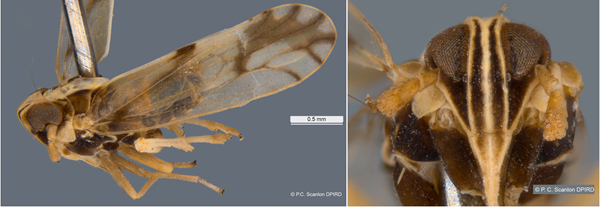*Biosecurity threat, not present in Australia
Tagosodes spp
Rice Planthoppers
Caution
Many of the insects depicted on these pages are outwardly similar and you should not use photographs as the sole means of identification. These pages form part of a scientific key which will assist a trained entomologist to identify the species accurately.
*Tagosodes cubanus (Crawford 1914)
*Tagosodes orizicolus (Muir 1926)
Tagosodes pusanus (Distant 1912)
Common Name: Rice planthoppers
Subfamily/Tribe: Delphacinae: Delphacini
Distribution: Tagosodes pusanus is present in Australia (NT, WA, Vic, Qld), Timor Leste, Taiwan, Philippines, China, India, Pakistan and Indonesia (Bellis et al. 2013; Bartlett 2018). Tagosodes cubanus and T. orizicolus are both found throughout South and Central America, with both species extending into the southern states of the United States of America. Tagosodes cubanus also occurs in Africa (Nigeria, Ivory Coast) (Bartlett 2018).
Economic Status: Tagosodes orizicolus, T. cubanus and T. pusanus feed on grasses and the former two species can also feed on coconut palms. However, the most economically important host is rice, with T. orizicolus and T. cubanus being vectors of Rice hoja blanca tenuivirus (Bartlett 2018). Tagosodes orizicolus is also a possible vector of Mal de Rio Cuarto fijivirus in corn and wheat, crops of which T. orizicolus has fed on in laboratory conditions (see Mattio et al. 2008). Tagosodes orizicolus is included on the Plant Health Australia (2015) contingency plan for exotic sap-sucking insects of grains. Direct feeding damage on rice by Tagosodes planthoppers can cause loss of up to 80% of rice crops but the viruses that they transmit can cause the complete loss of the rice crop (Plantwise 2018).
Notes: There are twenty species globally (Bartlett 2018), of which only Tagosodes pusanus (Distant) is recorded from Australia (Bellis et al. 2013). The exotic species of Tagosodes can be mistaken for species of Sogatella which are present in Australia and accurate diagnosis ultimately requires examination of male genitalia (Bartlett 2018).
|
Tagosodes oryzicolus (Muir) |
Tagosodes pusanus (Distant) |

